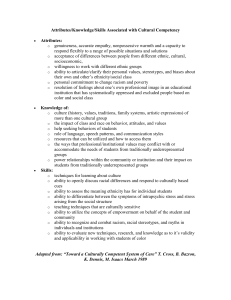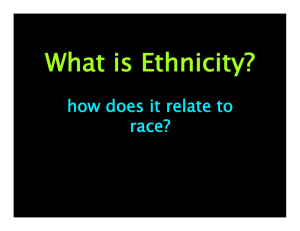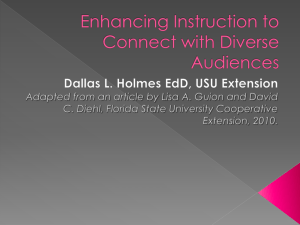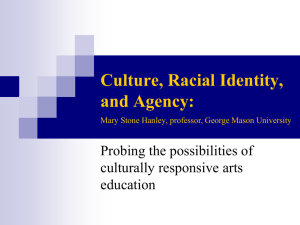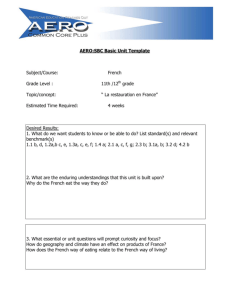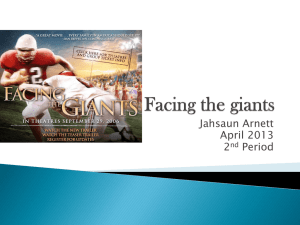Culturally Relevant Pedagogy - Florida Music Education Associations
advertisement
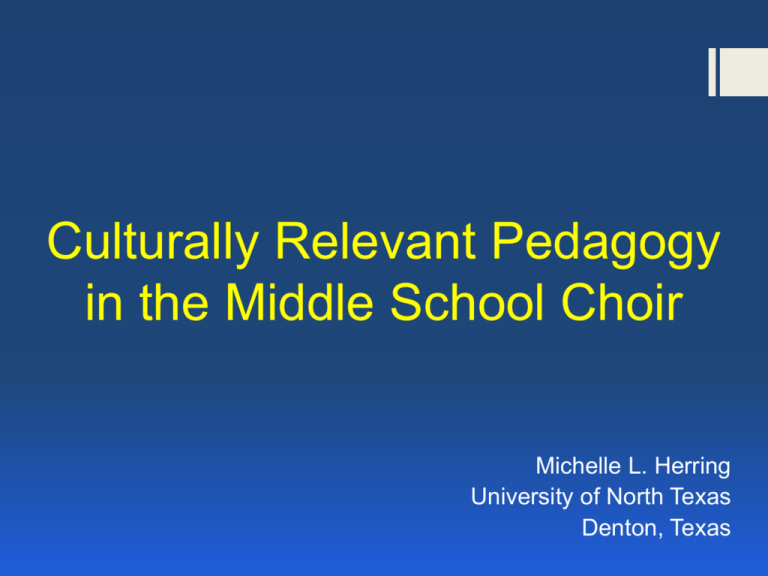
Culturally Relevant Pedagogy in the Middle School Choir Michelle L. Herring University of North Texas Denton, Texas After the panel, we had the opportunity to have dinner with the panelists at the Century City Marriott. Since Ms. Gruwell works at a Marriott on the weekends, the hotel let us have a big dinner there. When we got to the hotel, we were able to walk up to the panelists and shake their hands. During dinner, Renee came to speak with us at my table. She showed us the tattoo on her arm from Auschwitz. The tattoo looked like little numbers from a barcode. She told us how some of the needles they used were infected and that some people got skin diseases. She told us how one person sucked out the ink from her skin because the doctors who gave her the tattoo quietly told her to. If she had not sucked the ink out, she would have been sent to the gas chamber the next day, because her number was called. Everything from today related to something we have read or watched in class. It’s amazing how Ms. Gruwell went out of her way to contact all these people to come to speak to us. By meeting these people, it made the books we’ve been reading more meaningful. It also made me realize that anything is possible! (1999, p. 43) Overview What is culture? Ethnicity? Race? Teacher/Student Demographics Culturally relevant/responsive pedagogy (CRP) Practical applications Background What is culture? Pre-1950s: behavior and customs (Banks, 2001; Bennett, 1999; Campbell, 1996) Current definition Knowledge Belief systems Symbols and meaning Languages and dialects Non-verbal communications Identification Macroculture Microculture How is culture transmitted? Parents Schools Religious organizations Other institutions or social groups Race Can include observable physical traits (Yetman, 1999) Social construction not a scientific truism (Campbell, 1996) Ethnicity A socially distinguished group Can be a race, religion, or national origin Set apart from the majority of society Four types of ethnic groups (Banks, 2001) Cultural Economic Political Holistic Who are we teaching? Students by Ethnicity and Gender: African American Hispanic White Asian/Pacific Islander Amer. Indian/AK Native Two or More Races Total Minority Students 612,465 762,854 1,131,901 70,766 9,888 80,282 1,536,255 22.9% 28.5% 42.4% 2.6% .03% 3.0% 57.5% Economically Disadvantaged Limited English Proficient (LEP) Male Female 1,535,670 234,451 1,371,153 1,297,003 57.5% 8.7% 51.3% 48.6% Source: National Center for Educational Statistics Who is teaching? Teachers by Ethnicity and Gender: African American Hispanic White Amer. Indian/ AK Native Asian Pacific Islander Two or More Races Total Minority 22,616 22,593 122,738 499 1,806 133 1,483 49,130 13.1% 13.1% 71.4% 0.2% 1.0% 0.07% 0.08% 28.5% Males Females 35,093 134,283 20.7% 79.2% Source: Florida Department of Education School Monoculture School Culture Middle Class Eurocentric Female Dominated Hidden Curriculum CULTURE SHOCK! Passive reaction Aggressive reaction Frustrated!!! Culturally Relevant Pedagogy Culturally relevant pedagogy (CRP) supports curriculum that is sensitive to and non-judgmental toward the cultural backgrounds of students (Brown & Cooper, 2011). Enhancing students’ success by acquiring knowledge of their cultural backgrounds and translating this knowledge into instructional practice (Irvine, 2010) . A culturally relevant pedagogue is one that “teaches to and through the strengths of ethnically diverse students” (Gay, 2000) . Culturally Relevant Pedagogy Academic Success Cultural Competence Sociopolitical Awareness An Example… Objective: Students will create an ostinato composition using improvised instruments or body percussion based on a photo to perform in a community concert. http://nyportraits.blogspot.com/2010/07/singing-for-supper-in-washington-square.html Who are these people? What are they doing? Where are they? Why are they performing? How do they perform? Who is their audience? http://nyportraits.blogspot.com/2010/07/singing-for-supper-in-washington-square.html What is the musical role of each performer? What is each performer using as an instrument? What type of music do you think the performers were performing? Why? http://nyportraits.blogspot.com/2010/07/singing-for-supper-in-washington-square.html “It was brightly, painfully sunny and hot on Sunday. These wonderful singers donned sunglasses so they could sing in relative comfort. Street singers often animate their acts with hand gestures, shout-outs and poses. It's not enough just to stand there and sing. Singers need to cajole their audience to give up their hardearned cash. Most sane New Yorkers were inside or out of town, because of the intense heat. There was barely a breeze. I was silly enough to go shoe shopping and wound up walking around in circles, delirious and sweating. Oh, what we ladies do in the name of fashion!” http://nyportraits.blogspot.com/2010/07/singing-for-supper-in-washington-square.html Assignment (Cultural Competence, Academic Success) Form a group of five students Ask each group member to take on the role of one of the performers. Create an ostinato for that person using body percussion or an improvised instrument. Arrange the group’s ostinati into a 2-minute composition with a beginning, middle and end. Layering ostinato, a verse/chorus structure, or using a form similar to ABA can be ways to design compositions. Perform compositions for class. http://nyportraits.blogspot.com/2010/07/singing-for-supper-in-washington-square.html Community Extension (Cultural Competence, Academic Success) Perform compositions as a community recital Project or provide copies of the urban street singers photo to the audience. Nominate one person from each group to discuss interpretations of the photo. Perform each group’s interpretation of the assignment. Conclusions World is becoming more diverse, globalized As Music Educators we have an opportunity to reach many different cultures I encourage you to: Learn a new instrument Listen to a new genre Discover a new culture Learn from your students, they are the best teachers. Thank you! Michelle Herring University of North Texas mlherring13@gmail.com
